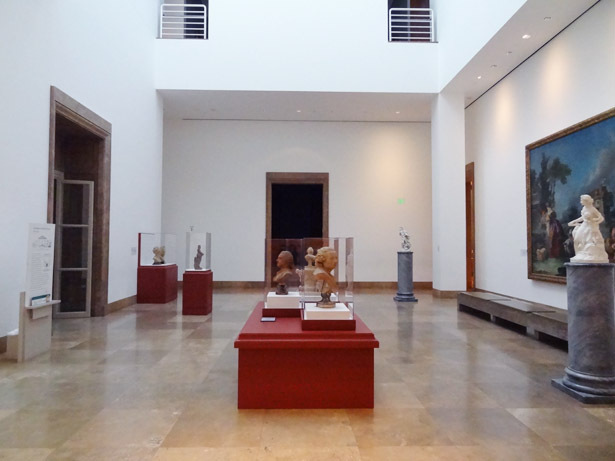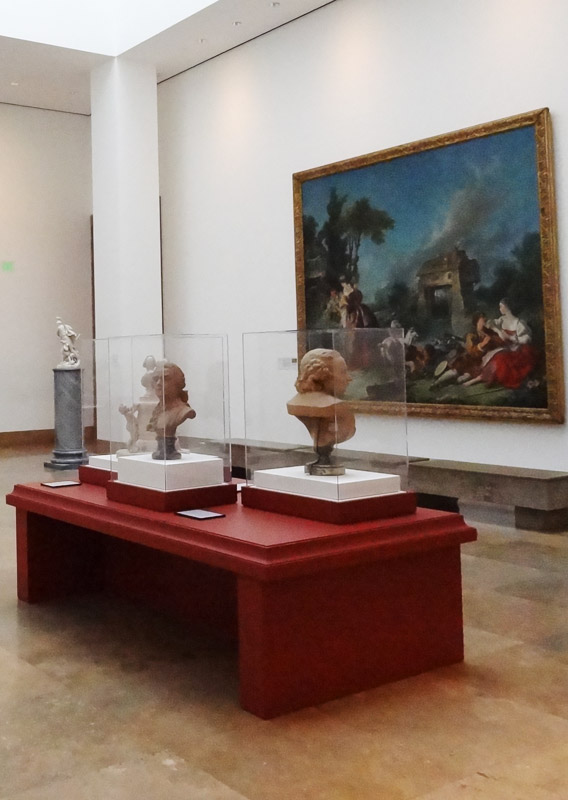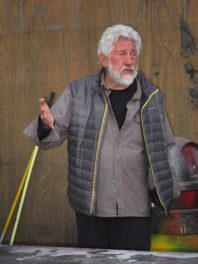
A view of the newly finished installation in the South Atrium at the Getty Center
The sculpture and decorative arts galleries in the West Pavilion, redesigned in August 2010, highlight the objects well—so well, in fact, that I bet no one has noticed that seven sculptures once in the West Pavilion have been off view since the reinstallation.
If there’s one thing that upsets museum curators, it’s when objects aren’t on display. When we take an artwork off view, even temporarily, it’s as if we are taking away its life. So, needless to say, since 2010 we’ve been working on finding a suitable home for the sculptures that lost their spots during the redesign. And now, they’ve just moved into their new home! A small but beautiful group of terracottas and marble statuettes created for private interiors in 18th-century Europe has just gone on view in the South Atrium of the South Pavilion.

Hope Nourishes Love (detail), 1769, Jean-Jacques Caffieri
The display features two marbles—Minerva by Augustin Pajou and Hope Nourishes Love by Caffieri—as well as seven terracottas, two male busts (82.SC.11 and 96.SC.344), two female heads (87.SC.114.1–2), and one statuette of Saint Bartholomew (94.SC.23).

Ideal Female Heads (detail), 1769–70, Augustin Pajou
I can’t say that these objects, when not on display in the galleries, enjoyed a peaceful rest in storage. Quite the opposite! Their life was pretty busy, and so were the lives of many of us who work with them. It was a perfect opportunity for curators and conservators to study them closely, scrutinizing them in detail and analyzing the materials and techniques involved in their creation. (This is an important step in the preparation of our upcoming online sculpture catalogue.) Photographers shot multiple views and details with the most up-to-date, high-quality cameras, and mount makers created secure systems to fix each piece onto their supports during installation. Preparators were entrusted with handling the objects during all this activity, while registrars kept track of the moves.

Column and machine to drill into the travertine floor to secure the pedestals in position (left); a column being positioned (right)
Other departments, in particular Design, Preparations, Exhibitions, and Education, but also Collections Information & Access and Security, were also involved, working on turning the South Atrium, a space initially not intended for art, into a perfect and safe jewel-case for the sculptures. The large potted palms, which harbor little bugs and humidity that we want to keep away from decorative art objects made of wood in the nearby galleries, were donated to a local non-profit organization, and a bench was removed. This has allowed more room to distribute all the sculptures harmoniously in the space so they can be appreciated from several viewpoints.

Top left to bottom right: Holes in the travertine floor, fixture on top of marble column, , fixture on bottom of marble column, removed travertine cylinders (with some concrete)
The two elegant marble columns on which Minerva and Hope Nourishes Love stand look like they were created on purpose to support these exquisite marble statuettes. In fact, we located them in storage. We display sculptures on antique pedestals as much as we can, and we were particularly lucky to find these two, which were a perfect fit.
Freestanding pedestals aren’t a good choice for terracottas, which need vitrines to protect them. So instead we faced a different challenge: what color to paint the cases? Our eyes landed on “Hot Apple Spice,” a red from the Benjamin Moore color chart. Evocative name, isn’t it? This red offers exactly what we were looking for in the display of the South Atrium: it invigorates our terracottas without outshining them, it stays in tune with the orange veins of the travertine floor, and it is a rich and warm color that will help the Atrium stay bright when the daylight from the very high ceiling weakens with the time of the day and the seasons. Last but not least, it matches the gowns of the two elegant ladies featured in the large painting hanging nearby, The Fountain of Love by François Boucher. In fact, it is Boucher who should be credited for our choice!

Installation view of the ‘Hot Apple Spice’ displays
Installing sculptures in an earthquake zone like Los Angeles requires many precautions and much work. I am not the right person to explain the details of seismic mitigation, but I am never a bored spectator when I attend the installation of the objects, each time amazed by the elaborate purpose-built systems and complicated operations. So, I turn photojournalist to keep a record of what becomes totally invisible once the installation is completed. I hope the images in this post pay homage to the work that conservators, mount makers, and preparators carefully accomplished to ensure a safe and beautiful display for the sculptures.
Now, it’s up to our visitors to come visit the South Atrium so these masterpieces can really start their new life!





Comments on this post are now closed.